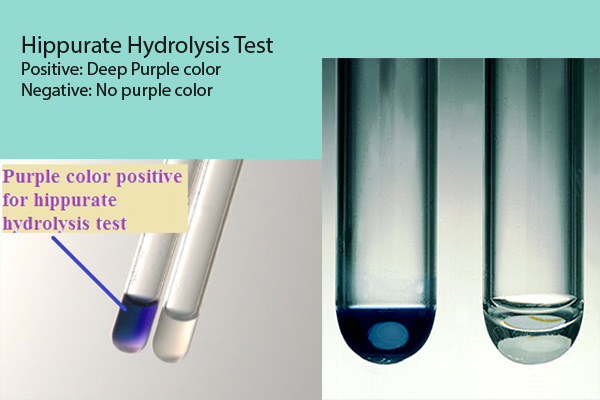Hippurate Hydrolysis Test- Principle, Uses, Procedure, Result Interpretation with Limitations
Hydrolysis Test- Principle, Uses, Procedure, Result Interpretation with Limitations
Hippurate Hydrolysis test
Hippurate hydrolysis test is used in the presumptive identification of Gardnerella vaginalis, Campylobacter jejuni, Listeria monocytogenes and group B streptococci, by detecting the ability of the organism to hydrolyze hippurate.
Principle
Hippurate hydrolysis positive organisms can hydrolyze 1% aqueous sodium hippurate to produce glycine and sodium benzoate. Glycine is deaminated by the oxidizing agent ninhydrin which gets reduced and becomes purple. The test medium must contain only hippurate, since ninhydrin reacts with any free amino acids present.
Significance
Used in the differentiation of β-hemolytic Streptococcus agalactiae from other β-hemolytic streptococci.
Aids in the separation of Campylobacter jejuni and Campylobacter coli strains.
Procedure
- Take a test tube and add 0.2ml (3-4 drops) of sterile distilled water.
- Make a heavy suspension of the organism to be tested from an 18-24 hour culture.
- Place a rapid hippurate disk in the mixture.
- Cap and incubate the tube for 2 hours at 35-370
- After the 2 hours of incubation, add 0.2 ml of the ninhydrin reagent to the mixture.
- Reincubate at 35-37oC for 15-30 minutes.
- Observe the tubes at 10 minute intervals for the appearance of a deep purple color.
Result interpretation
Positive: Development of a deep purple color within 5-10 minutes is a positive result.
Negative: No development of color within 5-10 minutes is a negative result.
Quality Control
Cultural Response
The Hippurate hydrolysis reaction is observed after an incubation at 35-37°C for 24-48 hours, of various bacteria with Hippurate differentiation discs, tested using Brain Heart Infusion Broth.
| Organism | Hippurate hydrolysis |
| Enterococcus faecalis ATCC 29212 negative : | precipitate if any, dissolves on shaking |
| Streptococcus agalactiae ATCC 4768 positive: | brown flocculan precipitate persisting on shaking after 10 minutes. |
| Streptococcus pyogenes ATCC 19615 negative: | precipitate if any, dissolves on shaking |
Limitations
- This test is only useful when distinguishing β-hemolytic streptococcus of human or bovine origin.
- A faint purple color is considered a negative result.
- Hippurate hydrolysis is also found in some species of other genera, such as Bacillus, Corneybacterium, Enterobacteriaceae, and others.
- The hippurate solution deteriorates in 7 days at 4°C.
- The ninhydrin solution deteriorates in 6 months.


Informative and doubt clearing
Thank you for providing the info on QC.
hi.thanks a lot it was clear and helpful.i wanted to ask the name of the hydrolize enzyme:)